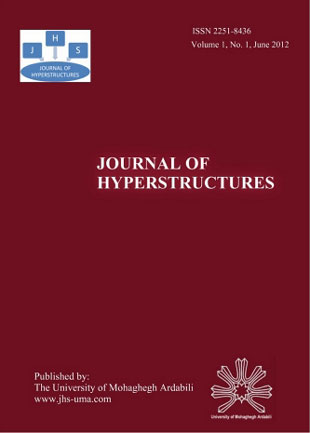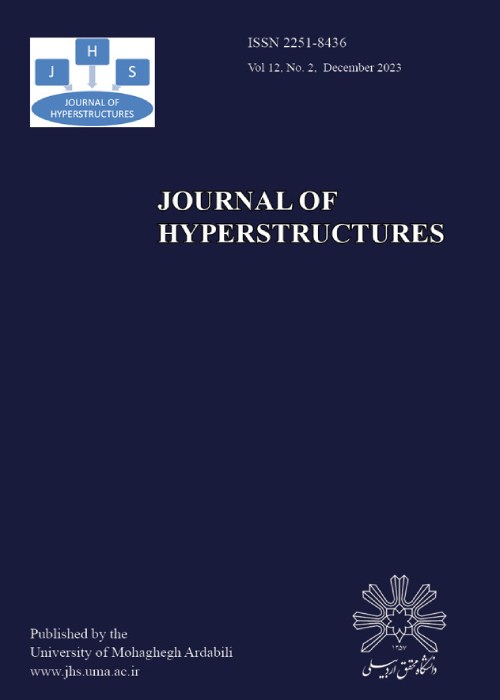فهرست مطالب

Journal of Hyperstructures
Volume:1 Issue: 1, Winter and Spring 2012
- تاریخ انتشار: 1391/05/04
- تعداد عناوین: 7
-
Page 1The purpose of this paper is to introduce and study soft semihyperring by giving importance both on attributes and functional value. In this paper the notions of soft semihyperring and its ideals are introduced and studied systematically. Prime (semiprime) soft hyperideals are defined and its characterizations are obtained. The regularity criterion for soft semihyperring is characterized by using the properties of (left, right) soft hyperideals.
-
Page 14Let $\mathcal M$ be a class of (mono)morphisms in a category $\mathcal A$. To study mathematical notions, such as injectivity, tensor products, flatness, one needs to have some categorical and algebraic information about the pair (${\mathcal A}$,${\mathcal M}$). In this paper we take $\mathcal A$ to be the category {\bf Act-S} of $S$-acts, for a semigroup $S$, and ${\mathcal M}_{sd}$ to be the class of strongly $s$-dense monomorphisms and study the categorical properties, such as limits and colimits, of this class.
-
Page 27In this paper the concepts of anti fuzzy prime ideals, anti fuzzy semiprime ideals and anti fuzzy ideal extensions in a semigroup have been introduced. They are found to satisfy characteristic function criterion and anti level subset criterion. Here some properties of anti fuzzy ideal extension of a semigroup have been investigated in terms of anti fuzzy prime and anti fuzzy semiprime ideals. Among other results we obtain characterization of prime ideals of a semigroup in terms of anti fuzzy ideal extension.
-
Page 41This paper calls for a relationship among the Actions of GroupG and M on Q (√m). It characterized several significant elements of G in terms of generators of M and vice versa. In this way we cultivate a correlation between the rudiments of these two Modular Groups. This will help us in discovering various Gand M-subsets of Q (√m).We have also generated an Algorithm by using Visual Basic for calculating the Congruence Classes of different Moduli and manipulating the Group Actions.
-
Page 52This paper deals with some issues of common fixed point theory involving two different types of intuitionistic fuzzy contractive mappings. Intuitionistic fuzzy Jungck''s common fixed point theorem (see, [1]) with respect to contraction defined in [8] and intuitionistic fuzzy Pant''s common fixed point theorem (see, [2]) for psi-phi weakly commuting mappings are proved.
-
Page 63In this paper we introduce new concepts as $LW^*W$ and $RW^*W$- property for a Banach algebra $A$, and we show that under certain conditions if $A$ has $LW^*W$ and $RW^*W$- property, then $A$ is Arens regular and also if $A$ is Arens regular, then $A$ has $LW^*W$ and $RW^*W$- property. We also offer some applications of these new concepts in group algebras.
-
Page 74Since fuzzy symmetric space is a generalized concepts of fuzzy metric space, in this paper, common fixed points theorems have been studied in fuzzy symmetric space instead of fuzzy metric space. Here, our target is to develop the common fixed points for a pair of weakly compatible self mappings, for four self mappings in fuzzy symmetric space. Using weakly compatibility, property(E.A.), we have established the unique common fixed point for four self mappings in fuzzy symmetric space.


